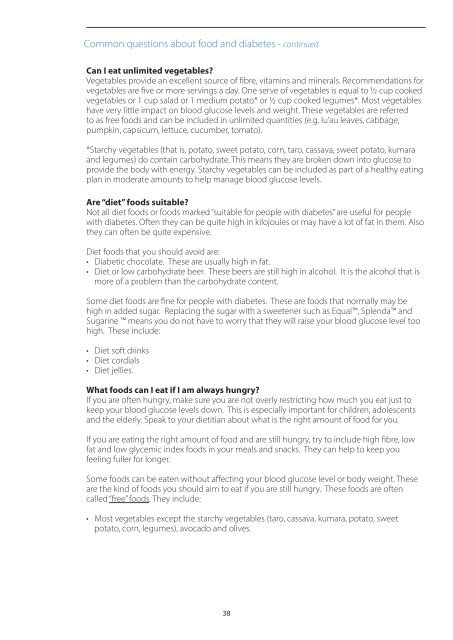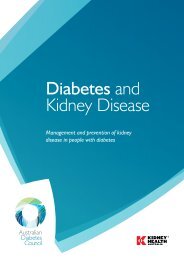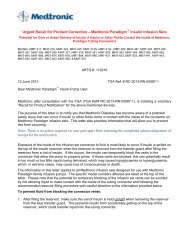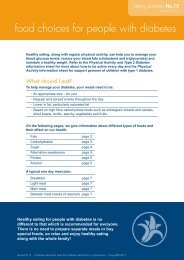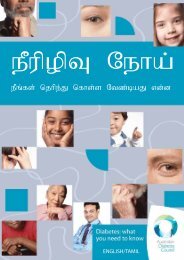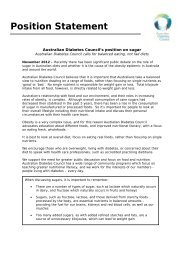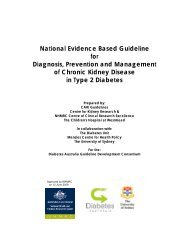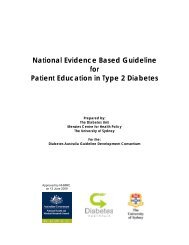O MeA e tAtAU OnA e IlOA - Australian Diabetes Council
O MeA e tAtAU OnA e IlOA - Australian Diabetes Council
O MeA e tAtAU OnA e IlOA - Australian Diabetes Council
Create successful ePaper yourself
Turn your PDF publications into a flip-book with our unique Google optimized e-Paper software.
Common questions about food and diabetes - continued<br />
Can I eat unlimited vegetables?<br />
Vegetables provide an excellent source of fibre, vitamins and minerals. Recommendations for<br />
vegetables are five or more servings a day. One serve of vegetables is equal to ½ cup cooked<br />
vegetables or 1 cup salad or 1 medium potato* or ½ cup cooked legumes*. Most vegetables<br />
have very little impact on blood glucose levels and weight. These vegetables are referred<br />
to as free foods and can be included in unlimited quantities (e.g. lu’au leaves, cabbage,<br />
pumpkin, capsicum, lettuce, cucumber, tomato).<br />
*Starchy vegetables (that is, potato, sweet potato, corn, taro, cassava, sweet potato, kumara<br />
and legumes) do contain carbohydrate. This means they are broken down into glucose to<br />
provide the body with energy. Starchy vegetables can be included as part of a healthy eating<br />
plan in moderate amounts to help manage blood glucose levels.<br />
Are “diet” foods suitable?<br />
Not all diet foods or foods marked “suitable for people with diabetes” are useful for people<br />
with diabetes. Often they can be quite high in kilojoules or may have a lot of fat in them. Also<br />
they can often be quite expensive.<br />
Diet foods that you should avoid are:<br />
• Diabetic chocolate. These are usually high in fat.<br />
• Diet or low carbohydrate beer. These beers are still high in alcohol. It is the alcohol that is<br />
more of a problem than the carbohydrate content.<br />
Some diet foods are fine for people with diabetes. These are foods that normally may be<br />
high in added sugar. Replacing the sugar with a sweetener such as Equal, Splenda and<br />
Sugarine means you do not have to worry that they will raise your blood glucose level too<br />
high. These include:<br />
• Diet soft drinks<br />
• Diet cordials<br />
• Diet jellies.<br />
What foods can I eat if I am always hungry?<br />
If you are often hungry, make sure you are not overly restricting how much you eat just to<br />
keep your blood glucose levels down. This is especially important for children, adolescents<br />
and the elderly. Speak to your dietitian about what is the right amount of food for you.<br />
If you are eating the right amount of food and are still hungry, try to include high fibre, low<br />
fat and low glycemic index foods in your meals and snacks. They can help to keep you<br />
feeling fuller for longer.<br />
Some foods can be eaten without affecting your blood glucose level or body weight. These<br />
are the kind of foods you should aim to eat if you are still hungry. These foods are often<br />
called “free” foods. They include:<br />
• Most vegetables except the starchy vegetables (taro, cassava, kumara, potato, sweet<br />
potato, corn, legumes), avocado and olives.<br />
38


